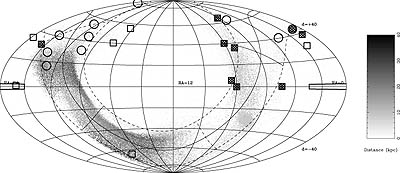 | |||
|
| Home > Public Information > Scientific Highlights > 2005 > The INT/WFC Survey of the Monoceros Ring: Accretion Origin or Galactic Anomaly? |
|
The INT/WFC Survey of the Monoceros Ring: Accretion Origin or Galactic Anomaly?
INT+WFC
The formation and evolution of galaxies remains one of the big questions in astronomy. In the currently favoured Λ cold dark matter model (ΛCDM), galaxies are built up over time via accretion
of smaller systems. One firm prediction of this model is that this accretion of smaller systems should still be ongoing and that the Milky Way halo should contain a large number
of satellite systems. It has been suggested that, given the model, there are too few satellites actually within
the Milky Way halo.
The tidal dismemberment of a dwarf galaxy as it falls through the Milky Way halo is a slow process, with extensive streams of tidal debris existing for long periods of time. While ancient remnants have been identified, via phase-space analysis, in our own Galactic neighbourhood, more extensive surveys of the Galactic halo have concluded that there is only a single, major ongoing accretion event, that of the Sagittarius dwarf galaxy. While this accretion event is adding mass to the Galactic halo and provides an important probe of the shape of the dark matter potential, the lack of other major accretion events is somewhat disconcerting given the predictions from the ΛCDM. The recently discovered Monoceros Ring (MRi, or the One Ring) can be interpreted as an additional ongoing accretion event within the Milky Way. Investigating the density and extent of this structure is important when trying to fully understand the impact this type of event is having on the evolution of our Galaxy both in the past and into the future. If the MRi is instead the outermost edge of the Milky Way, mapping the outer reaches of the disc will provide insight into the past of the Milky Way. Astronomers used the Isaac Newton Telescope Wide Field Camera to continue a campaign to detect this stellar population around the Galactic plane, mapping out the extent of the MRi in the region of Galactic longitudes l=61°—150° with 10 pointings in symmetric pairs above and below the plane of the Galaxy spanning 90° about the equator of the Milky Way.
This ongoing survey has yielded three detections of the ring in the region l, b= (118°, 16°), (150°, 15°) and a tentative detection at (150°, -15°). Galactocentric distance estimates to these structures gave ∼17, ∼17 and ∼ 13 kpc, respectively. These are combined with a re-examination of the field observed with the INT WFC in 2003, (123°, -19°), showing the position of the halo is not in accordance with the model and possibly represents another detection of the ring. The Galactocentric distance to this feature is estimated at ∼21 kpc. This provides evidence that the ring may be wrapped around the Galaxy more than once. These detections also lie very close to the newly discovered structure in Triangulum-Andromedae hinting at a link between the two. The remaining six observed fields are apparently non-detections although in light of the new models, closer inspection reveals tentative structure. With the overdensity of M giant stars in Canis Major being claimed both as a progenitor to the MRi and alternatively a manifestation of the Milky Way warp, much is still unknown concerning this structure and its connection to the MRi.
Both detections and non-detections support a complex picture of the MRi. In particular, those detections above the plane suggest the MRi has an extended stream tracing an arc ∼17 kpc from the Galactic Centre, while the detections below the plane,
reveal a tentative detection of the Triangulum-Andromedae region in the background of the (123°, -19°) region and also the presence of a foreground stream. Lying roughly in the plane of the Milky Way, the MRi may represent a unique equatorial accretion event which is contributing to the thick
disc of the Galaxy, or alternatively, the MRi may be a natural part of the disc
formation process. Obviously, the MRi is a very complex
structure and additional observations are needed to unravel its origins.
|
| Top | Back |
|


